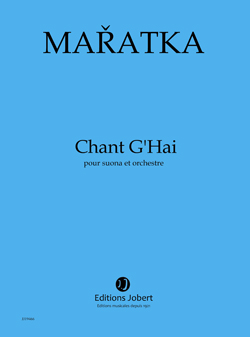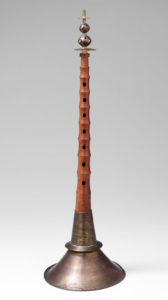CHANT G’HAI
for traditional suona (Chinese oboe) and symphonic orchestra
(2007-2010)

Duration: 13’
Commissioned by the Shanghai Spring Festival and Radio France
Instrumentation: Traditional Chinese Suona Solo (also playing Khou-sie), 3 flutes (including a flute in G), 3 oboes (each of which also playing a slide whistle of app. 30 cm - a “lotos flute”), 3 clarinets in B flat (including one bass clarinet in B flat), 3 bassoons (including one also playing double bassoon), 4 horns in F, 2 trumpets in C, 3 trombones, 1 tuba, 4 percussions, violins I, violins II , violas, violoncellos, 4 string double basses (minimum 8-8-6-6-4)
Percussions in detail:
- Perc.1: 2 tom-toms (treble, medium), high cymbals, washboard, 2 pebbles
- Perc.2: tom-toms (medium, bass), low cymbals, washboard, wood chimes, rattle, snare drum
- Perc.3: bass drum, jingle bells, tubular bell in B flat, rattle, wood block
- Perc.4: 2 congas, tubular bell in G, tambourine, slapstick, maracas, claves
Premiere: Final version by Hu Chenyun (suona), Radio France Philharmonic Orchestra, François-Xavier Roth - conductor, May 4th, 2010, Shanghai Grand Theatre, as part of the Shanghai World Expo 2010
Publisher: The Henry Lemoine Editions display more information on this work on
http://www.henry-lemoine.com/fr/catalogue/compositeur/maratka-krystof
For more information, contact:
Henry Lemoine Editions – Paris
Mrs Laurence Fauvet - Rental and purchase of score
orchestre@editions-lemoine.fr / +33 (0) 1 56 68 86 75
Jobert Editions
Henry Lemoine Editions – Paris
Mr. Benoît Walther - Promotion and distribution service
bwalther@editions-lemoine.fr / +33 (0) 1 56 68 86 74
Jobert Editions
Recording:
Hu Chenyun, suona / Orchestre Symphonique de Shanghai / Zhang Yi, conductor
Extract from the score:
Composer’s notice:

I got very interested in the “Suona” after I received the Shanghai Spring Festival and the Radio France Présences Festival’s proposal to write a work for a Chinese traditional instrument and symphonic orchestra on the occasion of a “composition competition” (2007-2010) with the collaboration of the Shanghai Symphony Orchestra and the Radio France Philharmonic Orchestra. This invitation was followed by my meeting with Hu Chenyun, suona player and soloist of the Shanghai Traditional Instruments Orchestra. His spectacular playing, as well as his art of talking about his instrument, and simply his passionate personality as a musician, greatly exalted my inspiration.
When I finished the score, I realized that one could see in it a reflection of the evolution of the Suona and of its history in China:
- The arrival of the Suona in China (the big solo at the beginning)
- The Suona spreading in North China (Tibetan horns)
- The expansion of the Suona throughout the country (a soft and intimate song’s melisma played by the soloist on the “Khou-sie”, a traditional instrument of the Peking Opera)
- Nature (evocation of birds’ songs)
- For a better world...? (brief theatrical intermezzo)
- Shanghai, the Suona in the modern and active city of today (final part).The traditional Suona (the Chinese oboe) is a wind instrument with many facets and a long history. Its name suona indicates its Middle Eastern origins, from the Arabic zurna. Already present at the time of the Jin dynasty in Central Asia, on the current territory of Xinjiang, it was introduced in China with the expansion of Islam. This cone-shaped two reed instrument is carved in wood and has seven finger holes in the front and one in the back. The wooden body is covered with a copper tube and a brass bell is attached to the lowest end.
The Suona can produce a wide variety of tonal qualities. It can render a very resonant and penetrating sound and is therefore perfectly suited to the illustration of strong emotions. First dedicated to Guchui military music from the North before becoming popular as an outdoor instrument, it joins local orchestras for celebrations of all kinds and is often used as an accompaniment instrument for regional Chinese operas.
After the 16th century, the Suona became an instrument of the Ming imperial court and has since been one of the most popular wind instruments of the Han people. More than twenty Chinese ethnic minorities play the suona today, but it is also found in more than 30 other countries in Asia, Africa and Europe...”
Kryštof Mařatka

